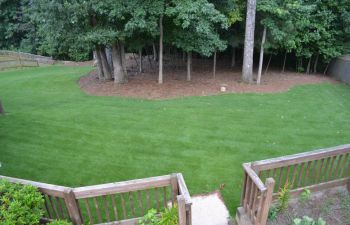
Falling trees contribute to tragic deaths and tens of millions of dollars in property damage each year. This leaves many homeowners with the responsibility of knowing how to spot a dangerous tree so that it can be removed before it causes harm. It is best to inspect your trees every season, especially the ones that are over a play area, near your house or close to your neighbor’s property.
You can conduct a comprehensive tree inspection and detect dangerous trees by examining the following four zones:
- The Overall Tree
- This involves putting yourself at a distance from the tree so that you can get an accurate view of its overall shape, growth pattern, fullness, etc. Is the tree leaning more than usual? Are there areas of dead branches or thin leaf coverage?
- The Ground
- It is possible that the tree stands tall, appears green and healthy, yet has a compromised root system. A tree’s root system is vital to its support. There are structural roots that anchor it (the visible roots) as well as absorbing roots (the numerous roots below the ground that carry soil nutrients). Inspect the ground around the base of the tree for the following:
- Visibly rotted or cracked anchoring roots
- Fungal growth (mushrooms) near the roots and trunks
- Cracked or raised soil (sign of uprooting)
- Dead branches on the ground
- The Trunk
- The trunk is what supports the weight of the branches and keeps the tree from toppling over. To detect a failing tree trunk, look for areas of weakness or disease. Are there cracks, cavities or “bald spots” (areas of no bark) on the trunk? Also, do you see signs that insects have attacked? Insects often attack a sick tree’s trunk, leaving visible holes and sawdust shavings. These are all signs that your tree’s trunk is sick or has a fungal infection and needs treatment.
- The Canopy
- The canopy inspection involves examining the tree’s branches and leaves. Here you’ll want to look for signs of dead wood, a red flag of a dangerous tree. Dead wood is easily spotted by the presence of branches that don’t have any leaves or branches that have shedding bark. In addition, look for broken branches after strong winds to spot weak areas in your tree that may be decayed or diseased.
If you are concerned about the health of one of your trees, call us at Pannone’s Landscaping & Lawn Pros for a professional tree service and inspection. Your treatment may include nursing a diseased tree back to health, addressing an insect problem, cleaning out dead branches or complete tree removal. We always seek ways to save your existing trees, but never at the risk or expense of a dangerous tree posing harm to your family or causing property damage.
Posted on behalf of
1444 Buford Hwy
Cumming, GA 30041
Phone: (678) 294-0351
Email: pannoneslawnpros@gmail.com
Monday - Saturday 8:00 AM – 6:00 PM
